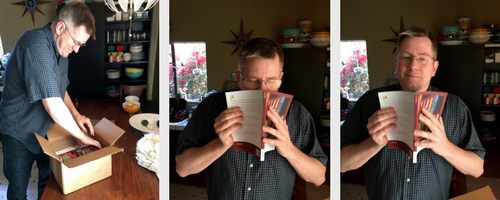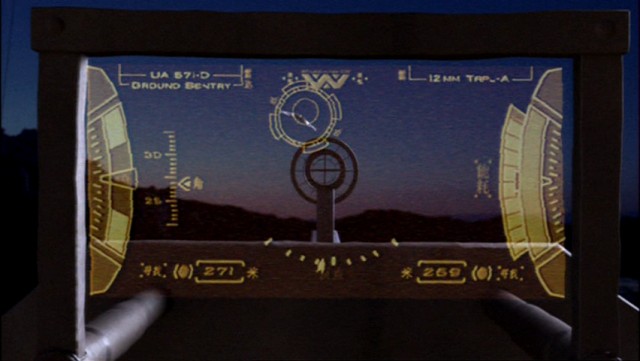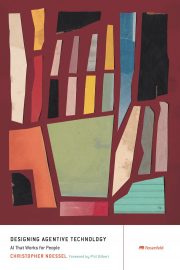-
Interview with Author Chris Noessel: Designing Agentive Technology
Posted on

Fans of Chris Noessel know him as a design veteran, teacher, lecturer who often draws fresh takes on UX through sci-fi films. These days, he leads design for the travel and transportation industry with IBM. His new book, Designing Agentive Technology, offers a practical guide for creating AI experiences for real people. Interest keeps growing in smart homes, self-driving cars, and robotic products with no sign of stopping. These agents are designed to make busy life less overwhelming. If designed well.
In the spirit of the book, we appointed Siri as our agent to interview Chris and find out more about what makes his brain tick. And what jazzes him about agentive tech. Enjoy.*
Siri: Where were you born, Chris?
Chris: I was born “on the road” in Virginia. My mother was in delivery while my Dad was pitching in an away game for the triple-A Braves. They announced my birth over the loudspeakers at the stadium, and my dad even threw a no-hitter that game. You’d think I’d be crazy for sports with that auspicious start, but the bug never bit me. It also means I was born in a state to which I have zero connection. Aside from being born there and spending a few weeks getting prepped to travel home, I think I’ve only driven through the state once.Siri: Where did you grow up, Chris?
Chris: I grew up in Texas. Specifically in the Ann Richards, libertarian-leaning Democrat, friendship-is-our-name-and-our-motto version of that state before the 1980s oil boom (and consequent cultural changes). I was white-blond as a kid and redheaded as an adolescent, so after a few ferocious sunburns, was told by the dermatologist to find some indoor hobbies. That suited me just fine. Board games, role playing, book reading, and movies became my thing.Siri: Three words that describe your childhood, Chris?
Chris: Peripatetic. Latchkey. Nerdy.Siri: Hm, I don’t see “peripetatic” in your commonly used words. Did you mean “periscope”, Chris?
Chris: Recategorize me as “capable of using uncommon words,” Siri.Siri: Very good, Chris. I’ll remember for next time.
Chris: That is apposite.Siri: Three things you never leave home without, Chris?
Chris: My keyring, with a Tile bluetooth tracker. An iPad mini for sketchnoting, reading, or playing games with my son. And some kind of camera. These days it’s an LG 360 cam.Siri: How would you describe “agentive tech” to a 10 year old, Chris?
Chris: An agent is like your own robot butler. He does stuff for you in the way you want it done, while you do other things. Can it do your homework? Yes, but then you wouldn’t learn anything. These robots can live in the world, or in the walls of your house, on your phone, or on the internet.Siri: What’s the best designed agent you’ve ever used, Chris?
Chris: Before the days of smart phones, I owned a Sangean RCR-1 Advanced Atomic Clock Radio. Imagine an alarm clock (your most basic agent) that automatically adjusted itself for daylight savings time. It had a slow-volume alarm that gently roused me out of sleep—before that was the norm. I could pick different alarm times for each day of the week. The interface wasn’t the best, but it treated me like a human with a life. It felt like I was living (and sleeping) in The Future.Siri: I’ll try not to take your response personally, Chris.
Chris: You’re only kind of an agent, Siri. Get back to me after you read Chapter 2. 🙂Siri: What other profession would you like to try if you could, Chris?
Chris: If I had the opportunity I’d love to do some professional worldbuilding, where you take a given speculative technology, think through the political, economic, social, and technological effects it might cause, then build a guidebook to that world. Since it’s largely the domain of cinema and television, the users of that guidebook tend to be production artists to help them make sets, props, and costumes that transform you into this new world.To do that kind of thing right, you’ve got to think through—everything. It’s tough to understate this, but you have to think through as much of the world as you can, from geology to evolution to business to human nature. Then you have to find ways those changes would be manifest such that are easy for us in our mundane world to understand and marvel at. The Precrime scrubber from Minority Report is one shining example. I get to indulge it slightly on the scifiinterfaces.com blog, but I would love to do it at a professional scale.
Siri: What’s the most embarrassing thing that’s happened to you while using an agent, Chris?
Chris: For a while I wore the Narrative Clip camera. It’s a “lifeblogging” camera that would automatically take pictures of your life throughout the day, then help you select the best ones to show you. But it turns out many more people than I realized felt it was an invasion of privacy, even if we were in a public space. Once, while I was speaking at a conference with it on, I announced to the audience what it was. A woman got up and walked out. I felt terrible. It really showed how deep our cultural and intrapersonal issues at play in these technologies.Siri: You seem to have bounced back from that quite well, Chris.
Chris: Thanks for the encouragement, Siri.Siri: If someone were feeling scared about artificial intelligence, what would you recommend they read from the book to give them a confidence booster, Chris?
Chris: Read Chapter 2. You’ll learn about the different types of AI and realize it’s not as sci-fi as you think. Narrow AI actually gets safer as it gets smarter, and there’s a fighting chance that the output of a world with lots of agents will help make the next world with general AI a lot safer, too.Siri: Knowing what you know now, what advice you’d give to your younger self, Chris?
Chris: Finish that book about the digital e-book before the window of interest closes. Overdocument your process. Market yourself and your ideas–even though you hate it. Learn from everything. Breadth of information is a superpower, don’t let the academic worship of depth guilt you. Carpe diem is neither a fish nor a panacea. Overthinking is going to pay off in the long run, but you have to learn how to play it off in parties. Your employment is not a marriage contract: The business will drop you when it’s in its interest, so treat your loyalty as a nice-to-have. Deadlines always slip, so accept that offer to be flown to New Zealand to speak at that conference, even if it currently conflicts with the launch of the new project.Siri: Would you ever consider using an agent to officiate your wedding, Chris?
Chris: Very clever, Siri. If you’re nominating yourself for the job, you’ll have to wait for a word from me.Siri: …
Chris: Patience, Siri.*Siri is used in a fictitious manner.
Chris Noessel is the Global Design Practice Manager for the Travel and Transportation sector with IBM, bringing IBM Design goodness to his vertical. He also teaches, speaks about, and evangelizes design internationally. His spidey-sense goes off semi-randomly, leading him to investigate and speak about a range of things from interactive narrative to ethnographic user research, designing for the future. He’s the author of Designing Agentive Technology: AI That Works for People, and co-author of Make It So: Interaction Design Lessons from Science Fiction, and About Face: The Essentials of Interaction Design. He blogs about UX lessons from science fction at scifiinterfaces.com, Follow Chris on Twitter and use #agentivetech to join or follow the conversation.
New Book Out Today: Designing Agentive Technology
Posted on
The timing for our newest book Designing Agentive Technology couldn’t be better. AI has moved from being the “next big thing” to being the thing for designers to grapple with. I’ve even done some research that demonstrates how important AI and machine learning are to UX people.
Technology has been getting smarter for years, and many of us have already been integrating AI into designed experiences. Think Siri, Alexa, wearables, automatic pet feeders, self-driving cars.If you’re venturing into the world of AI this year (or just thinking about it), there are two reasons you should consider picking up a copy:
- It’s practical. When it comes to AI, there simply aren’t a lot of books—yet—that provide such practical guidance to designers. Kudos to Chris for making designing agents clear and concrete.
- It’s necessary. Technology always races ahead, forcing us slow-moving humans to catch up with its impacts. Those impacts can be troubling and even destructive. We need to work harder to humanize the technologies we create, and no single group will be more important to those efforts than designers. See this book as preparation for rehumanizing AI.
You can read a free excerpt from Designing Agentive Technology from Designing Agentive Technology in today’s A List Apart. The book—like all of our titles—is available in just about every format you might need: a lovely color paperback, and PDF, MOBI, EPUB, and DAISY digital formats. You can purchase your copy from us directly, or make Jeff Bezos even richer. Let us know what you think of Designing Agentive Technology.I’m afraid I can do that, Dave
Posted on
There are moments when lots of little inklings that had been hovering in one’s periphery suddenly snap together to form a coherent thought. One of those that informed this book happened as I was working on my prior Rosenfeld Media book, Make It So. I was describing at the HUD of the anti-aircraft weapon that Mal uses in Serenity Valley, which looks a little something like this…

Firefly, Pilot Episode You see that the interface has two reticles. One that is hardware, physical, mounted to the weapon and showing where it is pointed; and another one that is software, showing where the bad guy is. I was about to go on to discuss the Weyland-Yutani logo at the top when I wondered
Wait…if the weapon already knows where the bad guy is, why does it wait for Mal to aim it when it could just aim it itself?
Of course Hollywood (or the TV-equivalent anyway) is wrestling with the notion with how to keep heroes heroic in the face of technology that can do so much stuff, and so they bypass this dilemma. But for those of us in the real world: If the gun could aim itself, what would we call that category of tech? What are its defining characteristics?
These questions snapped together patterns I’d seen across interaction design clients, about the logical end result of considering users’ goals and working to minimize their effort while maximizing effectiveness. It seemed to draw in lots of related questions: What happens as sensors and actuators become more ubiquitous? How are we going to make genuine use out of all the big, social data we’re starting to accumulate? What happens when everything is connected and we start to suffer from option overload?
These questions lodged themselves like a server app in my brain: They stayed there, running all the time, checking in on the stream of projects completed, articles read, and thoughts thought. And eventually, over the course of maybe a year, I’d carved away enough of the negative space to see that underneath there was new category of technology. It’s one that we don’t have language for or a practice around, and that we’re going to have some awesome design challenges as we do more and more of this kind of tech called…called…crap. I realized I needed to name the thing.
So I’m dubbing it agentive tech for reasons that will become clear when you read more about it online, or hear more about it at speaking events. But I am really excited to be able to develop this material into something I can share with you because I honestly think it’s going to change the world, and we will have a big job ahead of us to help it change it for the better.
